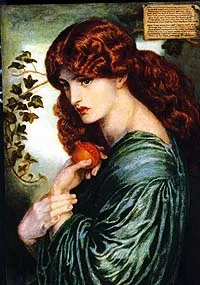A Review of Desperate Romantics: The Private Lives of the Pre-Raphaelites by Franny Moyle
2009 UK Cover
2011 US Cover
BOOK SYNOPSIS
In conjunction with a major series for BBC2, this work presents the scandalous saga of the Pre-Raphaelite Brotherhood. Their Bohemian lifestyle and intertwined love affairs shockingly broke 19th Century class barriers and bent the rules that governed the roles of the sexes. They became defined by love triangles, played out against the austere moral climate of Victorian England; they outraged their contemporaries with their loves, jealousies and betrayals, and they stunned society when their complex moral choices led to madness and suicide, or when their permissive experiments ended in addiction and death. The characters are huge and vivid and remain as compelling today as they were in their own time. The influential critic, writer and artist John Ruskin was their father figure and his apostles included the painter Dante Gabriel Rossetti and the designer William Morris. They drew extraordinary women into their circle. In a move intended to raise eyebrows for its social audacity, they recruited the most ravishing models they could find from the gutters of Victorian slums. The saga is brought to life through the vivid letters and diaries kept by the group and the accounts written by their contemporaries. These real-life stories shed new light on the greatest nineteenth-century British art. This title intends to tie in with a major television series on BBC 2. It features colourful characters, intimate lives, and it reads like a novel. It teaches about a major British Art movement through the medium of a cracking story. It contains gorgeous colour pictures that bring the characters and their art alive, and, Franny Moyle reveals the surprising truth behind Ruskin's public persona. The Pre-Raphaelites were the infamous, bad-boy celebrities of the late Victorian era and this book shows they are as compelling today as they were then. It brings together class, sexuality and morality in a scandalous saga.
Pre-Raphaelite Models
Annie Miller
Alexa Wilding
Fanny Cornforth
Jane Burden Morris
Lizzie Siddal -- The Infamous Ophelia
William Michael Rossetti, (Dante's brother) years later, remembered what the Pre-Raphaelites had looked for in their models: living people who, by refinement of character and aspect, may be supposed to have some affinity with those personages (that the painter intends to portray) - and, when he has found such people...he ought, with substantial though not slavish fidelity, to represent them as they are (Moyle, 98).
Ophelia went on show in the summer of 1852 as part of the Royal Academy Exhibitition.
In the 22 May 1852 issue of Punch magazine, pp. 216-7, one critic writes,
Before two pictures of Mr. Millais I have spent the happiest hour that I have ever spent in the Royal Academy Exhibition. In those two pictures I find more loving observation of Nature, more mastery in the reproduction of her forms and colours, more insight into the sentiment of our greatest poet, a deeper feeling of human emotion, a happier choice of a point of interest, and a more truthful rendering of its appropriate expression, than in all the rest of those eight hundred squares of canvas put together...
Talk as you like, M'Gilp, eminent painter, to your friend Mr. Squench, eminent critic, about the needless elaboration of those water mosses, and the over making-out of the rose leaves, and the abominable finish of those river-side weeds matted with gossamer, which the field botanist may identify leaf by leaf. I tell you, I am aware of none of these. I see only that face of poor drowning Ophelia. My eye goes to that, and rests of that, and sees nothing else, till - buffoon as I am, mocker, joker, scurril-knave, streetjester by trade and nature - the tears blind me, and I am fain to turn from the face of the mad girl to the natural loveliness that makes her dying beautiful(Moyle, 99-100)
MY THOUGHTS
As someone who fell in love with Waterhouse, Burne-Jones, Rossetti and Millais' paintings, I have read as much correspondence as was available online, biographies written by so called 'experts' and finally recommended fiction. I wanted to find out what a painter's inspiration truly was? Was it their muse or model, was it their surroundings, upbringing, class status, education or just an excuse to have a nude woman pose for them?
So, what have I discovered...Well, underneath the gruff exterior of the men of the Pre-Raphaelite Brotherhood lies the tortured lifestyle of an artist complete with the juxtaposition between a man's superego and crushing paranoia and insecurities! I quite like them these talented and neurotic painters, writers, and illustrators who have brought us some of the most realistic and painfully exquisite pieces of artwork based on poetry and literature of their day!
That is what you will find within the pages of Franny Moyle's 'Desperate Romantics' a tie in with a BBC television show of the same name!
Franny Moyle has written a sort of British Victorian soap opera. Yes, the painters and muses were real people who led interesting lives but because there is limited documentation throughout these artist's lives, we will never truly know every aspect of their inspirations for painting their subject's or why they pursued who they did! This is one of the weaknesses of 'Desperate Romantics'.
However, one of the strengths is the fact that it is well researched, well written and the pages are littered with lovely illustrations and excerpts of correspondence provide chapter examples.
So, I recommend it as pure enjoyment and escapism not part of your research. For that I would recommend Jan Marsh, Lucinda Hawksley, Josceline Dimbleby or Suzanne Fagence Cooper!
Please feel free to leave any questions or comments,








Comments
Rossetti's Wombat: Pre-Raphaelites and Australian Animals in Victorian London
John Simons